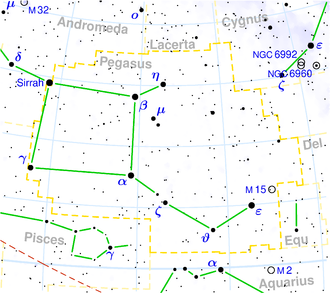NGC 7673
| Galaxy NGC 7673 |
|
|---|---|

|
|
| Photo from the Hubble Space Telescope | |
| AladinLite | |
| Constellation | Pegasus |
|
Position equinox : J2000.0 , epoch : J2000.0 |
|
| Right ascension | 23 h 27 m 41.0 s |
| declination | + 23 ° 35 ′ 21 ″ |
| Appearance | |
| Morphological type | (R ') SAc? / pec / HII / Sbrst |
| Brightness (visual) | 12.5 mag |
| Brightness (B-band) | 13.2 mag |
| Angular expansion | 1.3 ′ × 1.2 ′ |
| Position angle | 57 ° |
| Surface brightness | 12.8 mag / arcmin² |
| Physical data | |
| Affiliation |
NGC 7678 group LGG 474 |
| Redshift | 0.011368 ± 0.000003 |
| Radial velocity | (+3408 ± 1) km / s |
|
Stroke distance v rad / H 0 |
(160 ± 11) · 10 6 ly (49.2 ± 3.4) Mpc |
| history | |
| discovery | Albert Marth |
| Discovery date | September 5, 1864 |
| Catalog names | |
| NGC 7673 • UGC 12607 • PGC 71493 • CGCG 476-042 • MCG + 04-55-014 • IRAS 23252 + 2318 • KUG 2325 + 233 • 2MASX J23274105 + 2335201 • Mrk 325 • VV 619 • GC 6201 • NVSS J232741 + 233522 • LDCE 1578 NED002 • KPG 584A | |
NGC 7673 is a spiral galaxy with a high rate of star formation of the Hubble-type Sc in the constellation Pegasus in the northern sky . It is estimated to be 160 million light years from the Milky Way and about 60,000 light years in diameter. Together with NGC 7677 , it forms the isolated galaxy pair KPG 584 .
The type II supernova SN 2014ce was observed here.
The object was discovered on September 5, 1864 by the German astronomer Albert Marth .
Web links
- SIMBAD Astronomical Database
- ESA : Hyperactive galaxy NGC 7673 March 25, 2002
- Astronews
- Spacetelescope.org via NGC 7673
